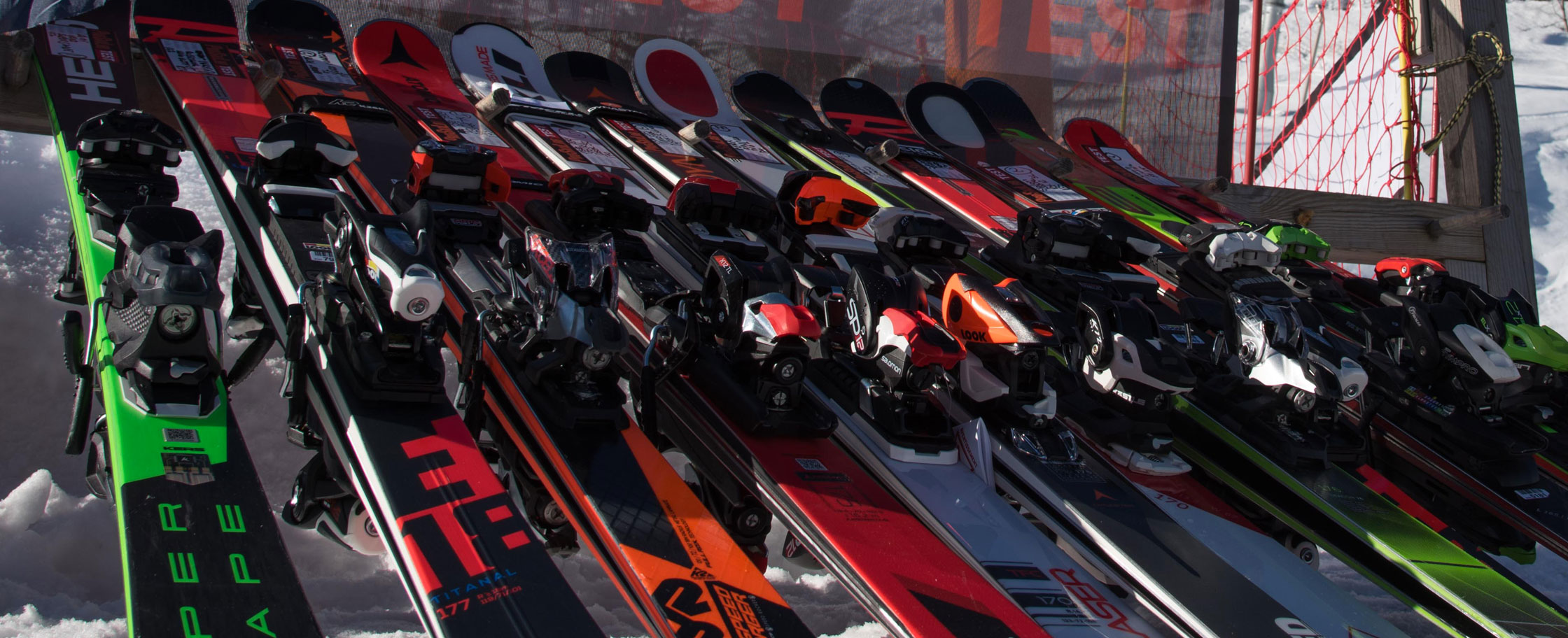
Why was the PROSKILAB review created?
We created the review in 2006 in order to add a buying guide to our Sports-hiver.com website in France and its European counterparts. The review was a quick success, encouraging us to give it a name and a dedicated website.
What do you mean by "buying guide"?
A "buying guide" is, first and foremost, an impartial guide that reliably guides visitors when choosing a pair of skis. As a regular skier and buyer, I wanted a review that us skiers could count on.
What was your first priority?
The first thing we had to do was to set up a methodology: analyse skiers' needs, split them into different categories, draw up specifications for each category, define the testing conditions, etc.
Then, a testing site had to be found, a team of testers had to be recruited, etc.
How did you choose the testing site?
We needed a ski area that would provide us with all kinds of conditions, orientations, and slopes. In addition, we wanted an area adapted to our logistical needs: a safe place to store skis, easy access to the testing base, etc. We started by organising the review in Chamonix, then in Les Deux Alpes, and we've been organising the review in La Clusaz in Haute-Savoie (France) for the last few years.
How do you recruit testers?
We wanted most of them to be experienced professionals who could push a ski to its limits and dissect how it behaves. So we recruit seasoned professionals, ski instructors and/or mountain guides. They're generally skiers who have an excellent technical level, being specialists in their field and/or former competitors.
Why do you highlight the fact that the PROSKILAB review is a "comparative" test?
All skiers know that a ski's ranking can vary depending on the weather, the skier, the snow conditions, and other factors. Testing one ski on Monday, then testing a competing model on Thursday in different conditions and with different testers, doesn't make any sense in our view. Therefore, we decided that the skis would be tested by the same panel of testers on the same half-day in order to have relatively consistent testing conditions. This greatly reduces the number of models tested but ensures the quality of the testing process.
How do you organise the testing week?
We start by making a list of the skis we've received and identifying each one with a sticker. We also take a look at the weather. The week's schedule is defined according to the specifications of each category, the snow conditions and the testers' availability. Certain categories have more demanding specifications and are, therefore, our top priority. For example, "performance" skis must be tested on hard snow, whereas all-mountain skis require powder snow.
What happens if there's no powder snow?
It's rare but unfortunately, it does happen. We keep the skis for a few extra weeks and then organise a second session.
You talked about preselection - how does this work?
Our desire to carry out a comparative review, as mentioned earlier, involves a major constraint. Actually, for a given category, a team of six testers can only test between six and eight skis in one half-day. This constraint is especially important for all-mountain and freetouring skis, which require more time. They must be tested both on- and off-piste. When the conditions require as such, we sometimes have to take our skis off to go and find fresh snowy slopes that are further away!
As a result, we have to select the skis that will be tested in advance, the aim being to offer the best possible selection with regard to the specifications while taking into account the brands' new features and commercial constraints. When possible, we pre-test the skis before including them in the test. This phase lasts three days, taking place in January.
In general, the selection made before the test already consists of very-good-level skis.
How do you select the brands?
We do not select the brands, only the skis. Certain brands aren't tested simply because they don't have any skis that are suitably adapted to our categories' specifications. For example, this is often the case with brands specialising in "freeride".
Some tests consider the concept of price - why not PROSKILAB?
We've deliberately eliminated the price factor, even though this is obviously important for the final consumer. Our aim is to try and identify the best skis on the market. Skis' pricing varies greatly depending on how far along the season is, and it's impossible to include this objectively. Therefore, it's up to the visitor to make the best choice while taking into account the prices available from the distributors in the "Where to Buy This Ski" section.
What is at stake in a test for a brand?
On the equipment side, launching a ski requires a lot of work, meaning a considerable investment with (logically) very strong commercial expectations. What's more, the test results obviously have a decisive influence over sales. For example, a "Best Ski" medal from PROSKILAB (measured by the number of clicks on commercial links) has a significant commercial impact. Therefore, the economic stakes are high.
We fund the review through the clicks visitors make to distributors in the "Where to Buy This Ski" section, managed by the Gearscore platform.
From the outset, we decided that the review would refuse any commercial or advertising relationship with the brands in order to preserve our editorial freedom. Some brands also expressed this same desire.
We're a little rigid in our thinking on the subject. We don't gain anything whatsover from the brands. I buy my skis like any other consumer.
Are some brands better than others?
In the long term, no. Analysing the PROSKILAB review results shows that innovative processes lead to the most highly rated brands changing over and over again.
One or more brands may take the lead in a category thanks to skis that dominate a market segment. But this only lasts a few seasons - the competition always comes back with improved models.
How do you perceive the brands' technical innovations?
Naturally, we don't just listen to the brands' technical and marketing discourse - we look at the bigger picture. There are real innovations, "fashion" trends, and marketing discourse. These are three different things. Testing allows us to put the skis in real-terrain conditions and put things in perspective.
What are your relations like with the brands?
They vary, depending greatly on the test results. When the models get good reviews, they are usually good. When that's not the case, they can be rather strained.
Do some brands put pressure on the review?
We've never been pressured into changing a rating or medal after testing. However, overall pressure does exist, which is only natural when considering what's at stake. Because we don't depend on the manufacturers' advertising budgets, the brands sometimes use other levers. Some brands leave the review and gradually come back.
How do you handle it?
There aren't many ways of looking at it. Either you do a discriminating test that serves skiers, with the brands that agree to play the game, or you do a test that pleases everyone, that is more in the realm of technical and commercial communication, but that leaves the consumer indecisive.
We made our choice 13 years ago. We refuse to "hand out" medals and ratings. Therefore, we must accept that some brands that are not very satisfied with the results will decide to no longer collaborate with PROSKILAB.
Moreover, the test is very selective in view of what we explained earlier. We cannot test every brand and model for every category, but we try and focus on the best skis.
Lastly, it's often temporary. A few seasons later, we gradually retest the brand when new models are released.
So the wheel turns, sometimes dramatically. Often, it only takes a particularly powerful model or range to radically change the leading group. A few years ago, brands that weren't rated very well have now returned to the top of the podium, thanks to new models!
How does the ski evaluation take place in practice?
The testers go off and test the skis, often in pairs, in order to facilitate information-sharing and allow for longer rotations. They fill in an evaluation sheet when they get back. At the end of the half-day, during the debriefing, we review all of the skis tested. We calculate the average ratings, read each tester's opinion, and discuss. We then write a conclusion for each ski. At the end of the debriefing session, the testers award the medals.
Do the testers always agree with each other?
No, not always! When there are differences of opinion regarding a model, we try and understand them. There may be differences in the opinions of professional and non-professional testers, which are generally due to different technical operation of the ski. There may also be differences related to the testers' size. We discuss these points during the debriefing. We take all of these parameters into account before writing the conclusion.
How is the "Best Ski" medal awarded?
The "Best Ski" medal is awarded to the skis that meet the category's specifications and stand out from the rest of the market due to their qualities. They are often models that have or will become points of reference in their segment.
The "Best Ski" medal for a category isn't awarded systematically. Sometimes, when the testers deem that no ski deserves a medal, we don't award any. Conversely, there may be multiple "Best Ski" medals in the same category.
Do you think you have achieved your goal, and if so, why?
I honestly think that we have. We wanted a reliable review and I think that after 13 years of effort, we now have it.
We get regular testimonials from skiers who tell us that they're delighted with the choice they made based on the results published by PROSKILAB. These testimonials are important and always make us very happy.
In addition, website visit statistics are another indicator of visitors' level of confidence in the review. Half a million skiers visit the PROSKILAB websites every year. About 70,000 of them click on the "Where to Buy This Ski" links.
Which models do you ski with?
Personally, I have a soft spot for race-type skis with a good dose of accessibility and all-mountain skis that are quite rigid: Völkl Mantra (two pairs), Scott Crusade, Rossignol Hero Elite St Ti R22, 9GS, Dynastar Mythic Rider, etc. The Elan Wingman 84 and the Stöcki Laser SC are on this year's buying list.
Are these skis tested by PROSKILAB?
Yes, they are generally skis that I really liked during the pre-selection sessions or the testing. If my memory serves me right, almost all of them received a "Best Ski" medal.


